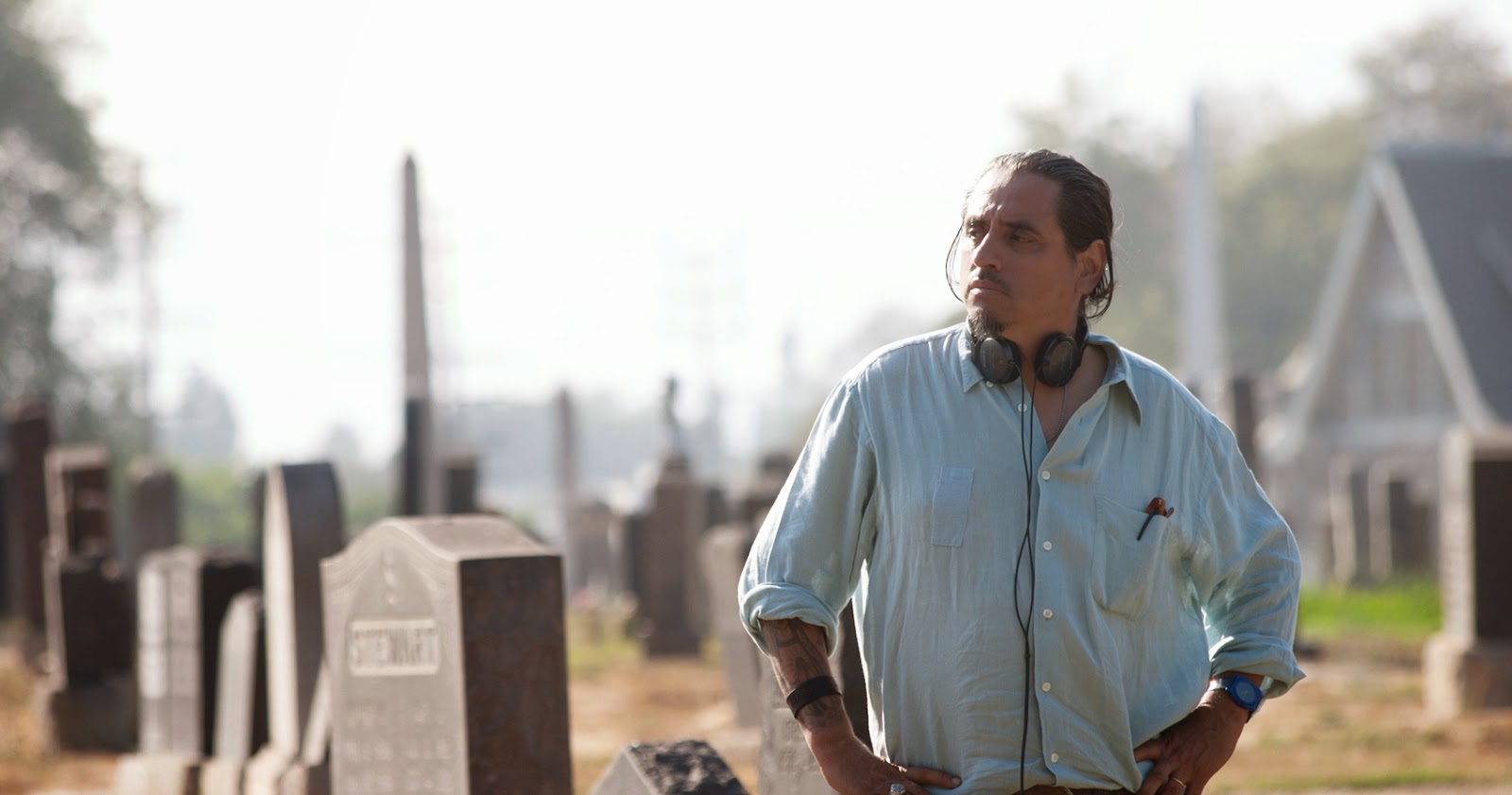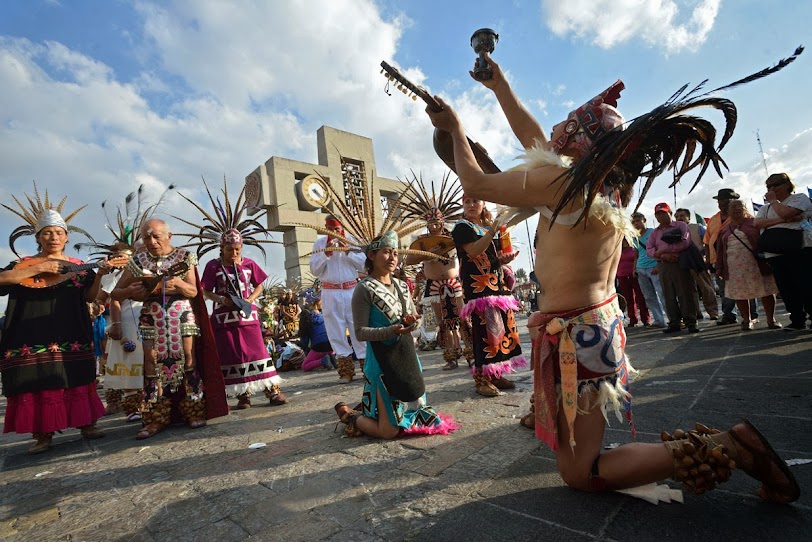Richard Montoya Talks 'WATER & POWER'
 | |
| Writer-director Richard Montoya on the set of Water & Power. Photo by Rafael Cárdenas. |
It’s just after 10:30pm on 1st Street in Boyle Heights. Richard Montoya arrives in his trademark sombrero campesino with Francisco Hernández, who is playing taxi tonight because Montoya’s vintage Cadillac hit the skids earlier during the week on his way to a City Hall Water & Power presentation with Council Member Gil Cedillo and Edward James Olmos. Hernández and Montoya go back, a long way back back far enough for Hernández to have been the natural choice for the assistant director slot on Water & Power, the debut feature written and directed by Montoya. Hernández wears a blazer with a silkscreened image of a ten-point buck across the back shoulders. The image is an early graphic representation of the film when it was still a work in progress. Tonight, Montoya carries a makeshift swag bag with posters and post cards announcing the film’s wide release on May 2nd.
“Soy el director de promociones,” says Montoya in his best imitation of a humble Mexican immigrant hawking wares with a subtle reserve. In this case, it is not sad or ironic at all but more the mark of a man who has been wearing multiple creative and practical hats for his entire life, first as a founding member of the legendary Latino comedy troupe Culture Clash, and—these days—as a new father, husband, East LA denizen, poet, screenwriter, playwright, and, yes, chief promoter of a neo-gothic noir turn on the screen that is a hyper-stylized version of the play he was commissioned to write by LA’s Mark Taper Forum – Center Theater Group in 2006.
The stage version, according to Variety critic Bob Verini, included at least one scene “so perfectly written, directed and played, so chilling and yet so hilarious, that it justifies the efforts of sketch comedy troupe Culture Clash to expand its artistic ambitions…” So yes, it’s Friday night in Boyle Heights, along a strip where many of the locals are wary of gentrification and white hipsters moving in because they’ve seen what has happened in Echo Park and what is now occurring in Highland Park. And Richard Montoya himself, like a number of those gathered at the M-Bar on this particular occasion, often has to straddle the fence.
While he is beloved across the city as a bona fide Chicano artist who is uniquely capable of telling original stories rooted in the history, culture and heritage of his Mexican and Mexican American forebears, he must also rub elbows with politicians and Hollywood types. He is also not averse to hanging out anonymously in the paisa (Mexican immigrant) bars with equal aplomb. It’s his first night at the M-Bar, the upstart nightspot that is, for most insiders, the only real alternative to East Side Luv, it’s older, trendier, and somewhat ritzier neighbor across the street. Montoya shot an entire scene inside the East Side Luv bar and is using ESL bartenders at a VIP downtown reception this week for a free Water & Power screening in the middle of Grand Park, a showing presented by Council Member Gil Cedillo and County Supervisor Gloria Molina.
Montoya has hired Buyepongo, an East Side cumbia powerhouse headed by Edgar “Metzli” Modesto. The swag bag he carries is for Edgar, whom he has never actually met in person. He knows they are playing the M-Bar this evening and wants to check them out, first hand. He’s asked Hernández to park slightly east of the both M-Bar and East Side Luv so as not to arouse suspicion or be spotted by anyone at East Side Luv who might take his visit to the M-Bar as a sign of disloyalty. It doesn’t matter that he’s been a regular at ESL for years and even held a press conference about his film there recently.
Opening for Buyepongo is a band called Viento Callejero led by guitar player Gloria Estrada, a former member of La Santa Cecilia. Buyepongo is doubling up and has another gig elsewhere in the city, so they have not yet arrived on the scene. But the M-Bar is packed in anticipation of a show with two of the most favored Chicano-Latino outfits on the East Side. Jason Zepeda, himself a founding member of La Chamba, LA’s most well-known exponent of cumbia chicha, a Peruvian take on the genre that uses guitar in the place of a keyboard, is on deck to handle monitors and sound. Across the street, off-duty officers from Hollenbeck are celebrating at East Side Luv with a much deserved boy’s night out. Less than a block away from the neighborhood’s famed Mariachi Plaza, Richard Montoya settles into a cozy M-Bar back patio where he is recognized by a line of people who know his work and have watched with pride as he has slowly—over the last two decades—woven himself into the fabric of life on the East Side, the East Side that is revealed and paid homage to in his film and which he has connected to artistically, spiritually and emotionally as an h eir to Chicanismo and Chicano art.
An adaptation of Montoya’s play, Water & Power was polished at the Sundance Feature Film Lab in 2007. The story rests with twins, Gilbert and Gabriel García, nick-named respectively Water and Power by their father, a blue-collar DWP employee who instills in them a sense of pride and responsibility. Gilbert grows up to be a senator and Gabriel becomes a senior LAPD officer who has done things under the cover of his badge for which he is ashamed of and for which he fully expects retribution. The film transpires through the course of a single night.
“Making Independent Cinema is not easy, but it is essential if we are going to be at the center of our story telling,” writes Montoya on his Facebook page, which is at the center of thousands of re-posts from friends and family who really want his film to succeed. Among them is acting powerhouse-cum-producer-director Edward James Olmos, who describes Water & Power as “masterful,” and was only too happy to sign on as one of the movie’s producers.
“We love Eddie. He got us those electronic billboards at the Citadel right on the 5 Freeway for a whole month to announce the film,” adds Montoya. “Imagine driving by at nght and those LCD lights, or whatever they are, say ‘Water & Power’ then switch to ‘Agua y Poder.’ For the Chicano and Chicana filmmaker, we’re promoting a whole movement to elevate each other’s work,” he says with regard to his support for the recent Cesar Chavez film by Diego Luna, who worked closely with the Cesar Chavez Foundation and the Chavez family to create a portrayal of the UFW co-founder that would be honest and respectful at the same time.
“We have a foundation here,” he says, addressing the hipsterization or gentrification of traditional neighborhoods where the poor Black and Latino populations are in danger of being displaced. “We didn’t just get here from Iowa with ä CBGB t-shirt. We [Chicanos] have all come from here or places very much like here.” We have a responsibility, he says, to uphold the integrity of those communities and the cultural life that made them vibrant when they were neglected and abandoned and ignored by everyone else.”
“We’re carrying a lot of water for a lot of people,” Montoya declares flatly, which something his film will do by turning the camera 180 degrees and depicting, albeit sometimes in dark, ominous tones, the eastside from the point of view rarely ever witnessed on the large screen. Later, at his new home somewhere on the southeastern corner of City Terrace, over crackers, cheese and wine, he says good night to his son Mountain, a small daredevil in skivvies and with a reluctance to sleep well beyond closing time and last call. His wife Consuelo, an administrator at Otis Art School tries hard to deal with the ardent resistance that surfaces when the child decides he wants to stay up with papá and a guest. as Montoya looks ahead.
“We have to find a way to get into the business of television,” Montoya explains, “Television is where the money is, and we should all be working, writing, you, me, the kids making web-TV… but the future is good in terms of telling more specific stories. “I tip my hat to Diego [Luna]. What’s left to us is making sure we don’t ever stop writing and telling our stories.
“Art is something we leave behind, and this is important. The awards, the dinners, the BS is nothing compared to the art, first and foremost. So in that context, our screenings are a call to action,” he says. “That’s why it’s so important to get out to support films and stories by us for us, the human race.”
Montoya is aware that his Chicano-centric take on LA will make many of those who are part of the industry uncomfortable. He is unafraid of the consequences. He is, after all, a peacemaker who has to balance opposing agendas, often from those who don’t realize that their move to the barrio, as artists or creative types, has its downside. While the newcomers to the East Side may sincerely feel that they are truly here to honor and respect the culture they have discovered, they are blind to the fact that their arrival represents a new kind of colonialism, one underscored viscerally in Water & Power.




Comments
Post a Comment